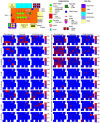Monitoring Seasonal Changes in Winery-Resident Microbiota
- PMID: 23840468
- PMCID: PMC3686677
- DOI: 10.1371/journal.pone.0066437
Monitoring Seasonal Changes in Winery-Resident Microbiota
Abstract
During the transformation of grapes to wine, wine fermentations are exposed to a large area of specialized equipment surfaces within wineries, which may serve as important reservoirs for two-way transfer of microbes between fermentations. However, the role of winery environments in shaping the microbiota of wine fermentations and vectoring wine spoilage organisms is poorly understood at the systems level. Microbial communities inhabiting all major equipment and surfaces in a pilot-scale winery were surveyed over the course of a single harvest to track the appearance of equipment microbiota before, during, and after grape harvest. Results demonstrate that under normal cleaning conditions winery surfaces harbor seasonally fluctuating populations of bacteria and fungi. Surface microbial communities were dependent on the production context at each site, shaped by technological practices, processing stage, and season. During harvest, grape- and fermentation-associated organisms populated most winery surfaces, acting as potential reservoirs for microbial transfer between fermentations. These surfaces harbored large populations of Saccharomyces cerevisiae and other yeasts prior to harvest, potentially serving as an important vector of these yeasts in wine fermentations. However, the majority of the surface communities before and after harvest comprised organisms with no known link to wine fermentations and a near-absence of spoilage-related organisms, suggesting that winery surfaces do not overtly vector wine spoilage microbes under normal operating conditions.
Conflict of interest statement
Figures





Similar articles
-
A tale of two vineyards: parsing site-specific differences in bacterial and fungal communities of wine grapes from proximal vineyards and their changes during processing in a single winery.Appl Environ Microbiol. 2025 Jun 18;91(6):e0052625. doi: 10.1128/aem.00526-25. Epub 2025 May 5. Appl Environ Microbiol. 2025. PMID: 40323100 Free PMC article.
-
Diversity of Saccharomyces strains on grapes and winery surfaces: analysis of their contribution to fermentative flora of Malbec wine from Mendoza (Argentina) during two consecutive years.Food Microbiol. 2007 Jun;24(4):403-12. doi: 10.1016/j.fm.2006.06.005. Epub 2006 Sep 1. Food Microbiol. 2007. PMID: 17189766
-
The impact of grape processing and carbonic maceration on the microbiota of early stages of winemaking.J Appl Microbiol. 2020 Jan;128(1):209-224. doi: 10.1111/jam.14462. Epub 2019 Oct 21. J Appl Microbiol. 2020. PMID: 31559682
-
Yeasts found in vineyards and wineries.Yeast. 2017 Mar;34(3):111-128. doi: 10.1002/yea.3219. Epub 2016 Dec 6. Yeast. 2017. PMID: 27813152 Review.
-
Non-Botrytis grape-rotting fungi responsible for earthy and moldy off-flavors and mycotoxins.Food Microbiol. 2014 Apr;38:104-21. doi: 10.1016/j.fm.2013.08.013. Epub 2013 Sep 6. Food Microbiol. 2014. PMID: 24290633 Review.
Cited by
-
Mapping microbial ecosystems and spoilage-gene flow in breweries highlights patterns of contamination and resistance.Elife. 2015 Mar 10;4:e04634. doi: 10.7554/eLife.04634. Elife. 2015. PMID: 25756611 Free PMC article.
-
Grape-associated fungal community patterns persist from berry to wine on a fine geographical scale.FEMS Yeast Res. 2023 Jan 4;23:foac067. doi: 10.1093/femsyr/foac067. FEMS Yeast Res. 2023. PMID: 36592956 Free PMC article.
-
Synergistic Effect in Core Microbiota Associated with Sulfur Metabolism in Spontaneous Chinese Liquor Fermentation.Appl Environ Microbiol. 2017 Dec 1;83(24):e01475-17. doi: 10.1128/AEM.01475-17. Print 2017 Dec 15. Appl Environ Microbiol. 2017. PMID: 28970229 Free PMC article.
-
Fungal and bacterial communities of 'Pinot noir' must: effects of vintage, growing region, climate, and basic must chemistry.PeerJ. 2021 Feb 4;9:e10836. doi: 10.7717/peerj.10836. eCollection 2021. PeerJ. 2021. PMID: 33604194 Free PMC article.
-
Complexity and Dynamics of the Winemaking Bacterial Communities in Berries, Musts, and Wines from Apulian Grape Cultivars through Time and Space.PLoS One. 2016 Jun 14;11(6):e0157383. doi: 10.1371/journal.pone.0157383. eCollection 2016. PLoS One. 2016. PMID: 27299312 Free PMC article.
References
-
- Bokulich NA, Mills DA (2012) Next-generation approaches to the microbial ecology of food fermentations. BMB reports 45: 377–389. - PubMed
-
- Peynaud E, Domercq S (1959) A review of microbiological problems in wine-making in France. Am J Enol Vitic 10: 69–77.
-
- Ocon E, Gutierrez AR, Garijo P, Lopez R, Santamaria P (2010) Presence of non-Saccharomyces yeasts in cellar equipment and grape juice during harvest time. Food Microbiol 27: 1023–1027. - PubMed
-
- Dolci P, Barmaz A, Zenato S, Pramotton R, Alessandria V, et al. (2009) Maturing dynamics of surface microflora in Fontina PDO cheese studied by culture-dependent and -independent methods. J Appl Microbiol 106: 278–287. - PubMed
Publication types
MeSH terms
LinkOut - more resources
Full Text Sources
Other Literature Sources
Medical
Molecular Biology Databases

